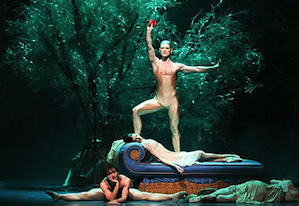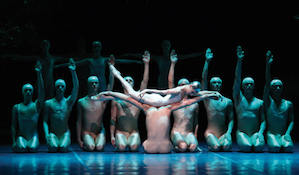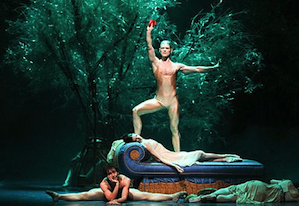
Photos by Holger Badekow
The San Francisco Ballet is hosting John Neumeier's Hamburg Ballet and his production of A Midsummer Night's Dream in the War Memorial Opera House for two performances only, on Feb. 12 and 13.
The choreographer of the two Hamburg productions seen previously in the War Memorial — The Little Mermaid and last season’s Nijinsky — created this work in 1977, but as it has girdled round about the earth, à la Puck, the piece is still developing and kept fresh. The music is a fascinating combination of Mendelssohn and Ligeti, costumes by Jürgen Rose.
Three decades ago, Anna Kisselgoff wrote abut the work in The New York Times:
This opening night, which consisted of Mr. Neumeier's truly spectacular treatment of A Midsummer Night's Dream, was the Hamburg Ballet's American debut and, as such, confirmed a point often made by the choreographer — namely, that his ballets come across best when danced by his own dancers.Having said that, it must also be said that Mr. Neumeier's great success in Continental Europe is linked to a taste for operatic theatricality that runs counter to the stripped-down-to-essence approach of more dance-oriented American choreographers back home. Mr. Neumeier, however, is working within a European opera-house structure — one in fact that appealed greatly to George Balanchine, when he staged ballets and operas in Hamburg in the 1960's.
...
Mr. Neumeier has reduced Shakespeare's play to a psychological study in the old reality-versus-illusion vein. In this version, it is Hippolyta, about to wed Theseus, the duke of Athens, who has a dream. She sees herself as Titania and, as such, seems to face her inner fears about her arranged wedding. Theseus and Oberon are one and the same.
In a combative, grappling first duet between Oberon and Titania, one might see Hippolyta's doubts about the physical side of her marriage. She and Theseus, in street dress, had previously been very formal with each other. This Dream, then is reduced to the story of Hippolyta's finding herself. It is a prosaic approach, hard on our expectations of the usual poetry resonating through Shakespeare's great allegory on love tested and true.

Showing the work's development over the years, Denise Richardson wrote in Dance Australia in 2012 when the Hamburg last toured there:
Faithful to the original tale apart from minor detail, it sparkles with humour and a lush sensuality that is captivating.Music is pivotal to the work. Not only does Neumeier describe each of its three worlds of the aristocratic Athenians, the fairies and the craftsmen by their movement vocabulary, but also by the accompanying score and its method of generation.
Thus you have Mendelssohn’s original incidental music to the play performed live for the aristocrats and a recording of the shimmering organ music of György Ligeti for the ethereal world of the fairies. For the craftsmen or mechanicals, there is the mechanically generated music of a barrel organ.
The ballet opens with the wedding preparations for Hippolyta to Theseus, Duke of Athens. Opulent, blue silk curtains are the backdrop to this short prologue, which buzzes with such frenetic activity, it pulls the focus in multiple directions.
We are introduced to the main protagonists of Hippolyta (Hélène Bouchet), Theseus (Ivan Urban), Philostrate (Alexandr Trusch), Helena (Leslie Heylmann), Hermia (Mariana Zannotto), and Demetrius and Lysander (Kiran West and Carsten Jung). Neumeier quickly establishes each character’s personality with both the music and detail in the choreography.
The colour palette is of creams and pale blues, the costume design (Jurgen Rose) elegant Regency. The movement evokes the refinement of the classical idiom, all pulled together with charm and a gentle ironic wit.

